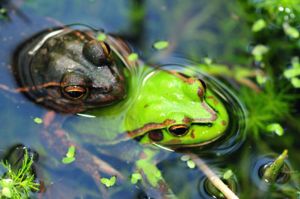<align=”center”>
A Current Affair: Burke’s Backyard week 3
<align=center>
This video requires the Adobe Flash Player. Download a free version of the player.
The children of Cabramatta Primary School @ Cabramatta in Sydney’s west have put together one of best gardens any school could possibly hope for.
The children have been named Garden Guardians by their teacher Joanne Laxton. With Joanne’s encouragement they have planted a range of edible plants relevant to their various ethnic cultures. They have managed to grow these in spite of the climatic conditions making it very difficult for the particular plants to flourish and which even the most experienced gardeners would have great difficulty with.
Plants grown include:
- Bananas
- Papaya
- Sugar Cane
- Lemon Grass
- Watermelon
- Citrus
- Leeks
Don offered them a range of tips for dealing with pests such as white curl grubs. The solution he suggested involved using nematodes (tiny worms) that will kill the larvae of the grubs. These nematodes can be obtained via www.ecogrow.com.au
For the children to see some interesting insects Don also suggested that they put some of the grubs into an old aquarium filled with potting mix & watch them grow into rhinoceros beetles. Rhinoceros beetles are among the largest of beetles. They develop horns which the male beetles use in mating battles with each other. They are said to be the strongest animals on the planet in relation to their own size since they can lift up to 850 times their own weight. Rhinoceros beetles & other fascinating insects can be purchased from the Australian Insect Farm – www.insectfarm.com.au
The children showed Don their pond which they wanted to make into a frog pond. Don told them an essential conditions for their pond to be successful was that it should be in a sunny warm area and not in a shady location. The pond also needed to be a larger size than the existing one so the children and Don built a new pond.
- A hole was dug approx 1.5 x 1.5 x 300mm deep
- Sand was spread over the surface of the hole to prevent putting holes into the liner which was installed next.
- Butyl liner was placed over the hole. The liner we used cost around $100. We purchased ours from Contour Ponds and pumps – ph 02 9690 2600
- It’s important to note if building a pond that while the gross excess should be trimmed there should be enough left so it can be folded over and a series of rocks placed on top of the folds to camouflage the liner.
- The children and Don then placed sandstone rocks around the edges then worked their way down into the pond with river stones so that it resembled a creek bed. Gaps between stones at the top of the pond were filled with sand so it had the appearance of a beach leading into the creek. River stones, lucky stones, river pebbles, river sand and sandstone flagging was obtain from Turtle Landscape Supplies – 02 9629 2299
- The pond was filled with water from the school’s rainwater tank
Then it was time for the tadpoles to be placed in the pond. Don had arranged for some very special frogs to be given to the children. These frogs were the very rare green and golden bellfrog and tadpoles were given to the school by Lance Jurd who has built up significant numbers of this frog that was extremely endangered before he began building up their numbers.
Food for the tadpoles was provided via fish food flakes and for frogs insects would be the main food. We set up twin tubes of black fluorescent lights in a standard base to attract insects. These came from Pro Lamps NSW If there is light near the pond this will attract insects at night. While they are not as effective at attracting insects we also installed a solar L.E.D. light & bug zapper which can be switched to either light or zapper option (note Lance Jurd pointed out that frogs generally will not eat dead insects so the zapper options would not be as good as the light). Our light was Nelson brand – www.nelsonlamps.com.au . Cost = $17.90 from Bunnings.
Information on the green and golden bellfrog can be found at http://frogs.org.au/frogs/species/Litoria/aurea/. Unfortunately green and golden bellfrogs are not generally available.
NOTE: We obtained special permission to place these endangered frogs into the pond at Cabramatta Primary School. If schools want to keep endangered wildlife they would need to get a licence from the National Parks organisation in their states.
Don also gave the children some interesting information about various animals:
Frogs swallow with their eyes – they use their eyes to push food down their throats.
Spiders such as red backs & funnel webs when eaten by birds don’t poison the birds.
Bites from funnel web spiders only affect humans, apes and some chimpanzees but if a funnel web bites a dog or a cat it won’t upset them.



